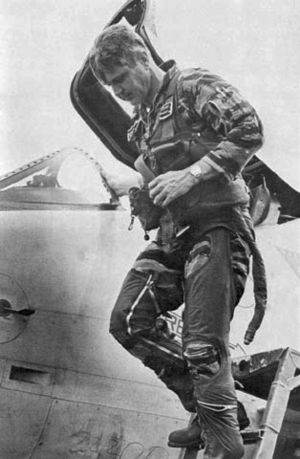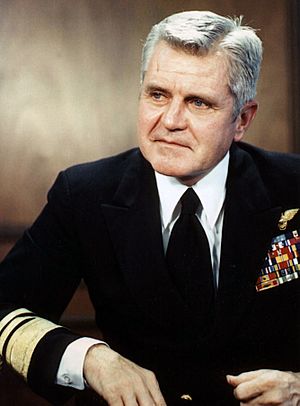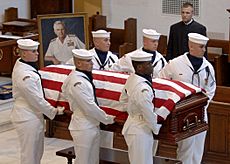James Stockdale facts for kids
Quick facts for kids
James B. Stockdale
|
|
|---|---|
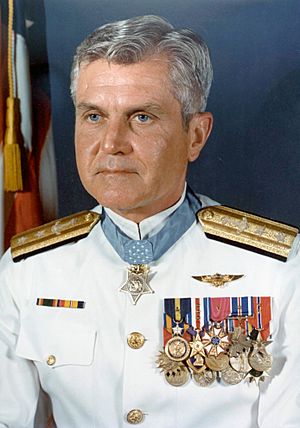
Stockdale as a rear admiral in
full dress white uniform (late 1970s) |
|
| Birth name | James Bond Stockdale |
| Nickname(s) | "Jim" |
| Born | December 23, 1923 Abingdon, Illinois, U.S. |
| Died | July 5, 2005 (aged 81) Coronado, California, U.S. |
| Buried |
United States Naval Academy Cemetery
|
| Allegiance | |
| Service/ |
|
| Years of service | 1946–1979 |
| Rank | |
| Commands held | VF-51 Carrier Air Wing 16 |
| Battles/wars | Vietnam War |
| Awards |
|
| Alma mater | Monmouth College, U.S. Naval Academy, Stanford University |
| Spouse(s) | |
| Other work | Vice-Presidential candidate, 1992 |
James Bond "Jim" Stockdale (born December 23, 1923 – died July 5, 2005) was a brave United States Navy officer. He was a pilot who became a vice admiral. He received the Medal of Honor, which is the highest military award in the U.S. He earned it for his actions during the Vietnam War, where he was a prisoner of war for more than seven years.
Stockdale was the highest-ranking naval officer held captive in Hanoi, North Vietnam. He led air attacks from the aircraft carrier USS Ticonderoga (CVA-14) during the 1964 Gulf of Tonkin incident. Later, his A-4 Skyhawk jet was shot down over North Vietnam on September 9, 1965. After his military career, he became the president of the Naval War College and later The Citadel.
In 1992, Stockdale was a candidate for Vice President of the United States. He ran with Ross Perot as an independent candidate.
Contents
Early Life and Education
James Stockdale was born in Abingdon, Illinois, on December 23, 1923. After a short time at Monmouth College, he joined the United States Naval Academy in Annapolis, Maryland, in June 1943.
Stockdale graduated from the U.S. Naval Academy in June 1946. He earned a degree in science. His first jobs were on different destroyer ships.
In June 1949, Stockdale was accepted for flight training. He became a Naval Aviator (a Navy pilot) in September 1950. In 1954, he trained to become a test pilot at Naval Air Station Patuxent River. He even helped teach U.S. Marine Corps pilot John Glenn (who later became an astronaut) in math and physics. He worked as a test pilot until 1957.
In 1959, the U.S. Navy sent Stockdale to Stanford University. There, he earned a master's degree in international relations in 1962. Stockdale loved being a fighter pilot more than studying. However, he later said that Stoic philosophy helped him a lot when he was a prisoner of war.
Vietnam War Service
The Gulf of Tonkin Incident
On August 2, 1964, Stockdale was flying over the Gulf of Tonkin. A U.S. Navy destroyer, the USS Maddox (DD-731), was attacked by three North Vietnamese torpedo boats. Stockdale and other pilots from the aircraft carrier USS Ticonderoga (CV-14) flew in to attack the retreating boats. They reported hitting the boats with their cannons.
Two nights later, on August 4, 1964, Stockdale was again flying overhead during a second reported attack in the Gulf of Tonkin. But this time, he saw no Vietnamese forces. He later said, "I had the best seat in the house to watch that event, and our destroyers were just shooting at phantom targets—there were no PT boats there."
The next morning, President Lyndon B. Johnson ordered bombing raids on North Vietnamese targets. He said these were in response to the August 4 incident. When Stockdale was told to lead these attacks, he asked, "Retaliation for what?" Later, as a prisoner, he worried he might be forced to reveal this secret about the war.
Becoming a Prisoner of War
On September 9, 1965, Stockdale was flying a mission over North Vietnam. His jet was hit by enemy fire and completely stopped working. He had to eject from his plane and parachuted into a small village. There, he was badly beaten and taken prisoner.
Stockdale was held as a prisoner of war in the Hỏa Lò Prison, also known as the "Hanoi Hilton." He was there for seven and a half years. As the highest-ranking naval officer, he helped organize resistance among the prisoners. He encouraged them to communicate and resist their captors.
Early in Stockdale's captivity, his wife, Sybil Stockdale, helped start an organization called The League of American Families of POWs and MIAs. This group worked to bring attention to the mistreatment of American prisoners. Sybil Stockdale even spoke about it at the Paris Peace Talks.
Stockdale was one of eleven U.S. prisoners known as the "Alcatraz Gang." They were resistance leaders and were kept separate from other prisoners. They were held in small, windowless concrete cells and locked in leg irons every night.
The Stockdale Paradox
James C. Collins once talked with James Stockdale about how he coped as a prisoner. Collins asked which prisoners didn't survive. Stockdale replied:
- "The optimists. Oh, they were the ones who said, 'We're going to be out by Christmas.' And Christmas would come, and Christmas would go. Then they'd say, 'We're going to be out by Easter.' And Easter would come, and Easter would go. And then Thanksgiving, and then Christmas again. And they died of a broken heart."
Stockdale explained that the ones who survived faced the harsh reality of their situation. They kept hope that they would eventually get out, but they didn't pretend things were better than they were. Collins called this idea the "Stockdale Paradox." It means you must never lose faith that you will succeed in the end, but you must also face the most difficult facts of your current reality.
Return to the United States
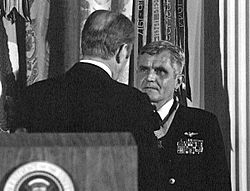
Stockdale was released as a prisoner of war on February 12, 1973. This was part of a program called Operation Homecoming.
On March 4, 1976, Stockdale received the Medal of Honor for his incredible bravery. Because of his captivity and mistreatment, Stockdale could not stand straight or walk well. He could no longer fly planes. The Navy honored his service by promoting him. He retired as a vice admiral on September 1, 1979. Before retiring, he served as the president of the Naval War College in Newport, Rhode Island.
Civilian Academic Work and Writings
After retiring from the Navy in 1979, Stockdale became the president of The Citadel, a military college. He later became a fellow at the Hoover Institution at Stanford University in 1981. For twelve years, Stockdale wrote and gave many speeches. He focused on ancient Stoicism and the philosopher Epictetus. Stockdale said that Epictetus's teachings helped him find strength during his time as a prisoner in the "Hanoi Hilton."
In 1984, Stockdale and his wife Sybil wrote a book together. It was called In Love and War: the Story of a Family's Ordeal and Sacrifice During the Vietnam War. The book shared Stockdale's experiences in Vietnam. It also told Sybil's story and how she helped start the League of American Families of POWs and MIAs. Their story was later made into a TV movie called In Love and War.
Vice Presidential Candidacy
Stockdale met businessman Ross Perot through his wife's work with POW families. On March 30, 1992, Perot announced that Stockdale would be his running mate for vice president. Perot was running as an independent candidate.
Stockdale was not told he would be in the vice presidential debate until a week before it happened. He didn't have much time to prepare. He also hadn't discussed political issues with Perot.
Stockdale started the debate by asking, "Who am I? Why am I here?" This question initially got applause. However, his debate style, including asking the moderator to repeat a question because his hearing aid wasn't on, made him seem confused to some people. This moment was even made fun of on the TV show Saturday Night Live.
For many American voters, this debate was their first time seeing Stockdale. The media often showed him as elderly and confused. This hurt his public image.
Even so, Perot and Stockdale received 19 percent of the vote in the 1992 presidential election. This was one of the best results for an independent ticket in U.S. history, though they didn't win any states.
Military Awards
Stockdale received many awards for his service, including:
- Medal of Honor
- Navy Distinguished Service Medal (three times)
- Silver Star Medal (four times)
- Legion of Merit
- Distinguished Flying Cross (two times)
- Bronze Star Medal (two times)
- Purple Heart (two times)
- Air Medal
Later Life and Death
Stockdale moved to Coronado, California, as he slowly became ill with Alzheimer's disease. He passed away from the illness on July 5, 2005, at the age of 81. His funeral was held at the Naval Academy Chapel. He was buried at the United States Naval Academy Cemetery.
Legacy and Honors
The Vice Admiral James Bond Stockdale Award for Inspirational Leadership is a United States Navy award created in 1980. It honors Stockdale's inspiring leadership.
The U.S. Navy has named several things after Stockdale:
- The guided missile destroyer USS Stockdale (DDG-106), launched in 2008.
- The main gate at Naval Air Station North Island in Coronado, California.
- The headquarters building for the Pacific Fleet's Survival, Evasion, Resistance and Escape (SERE) school.
In July 2008, a statue of Stockdale was placed at the U.S. Naval Academy. The building it stands in front of is home to the Vice Admiral James B. Stockdale Center for Ethical Leadership.
In 1989, the student center at Monmouth College, where he once studied, was named Stockdale Center in his honor. He was also added to the National Aviation Hall of Fame in 2002.
His naval experiences and leadership as a prisoner of war are an important part of every student's education at the Naval Academy.
Writings by James Stockdale
- Taiwan and the Sino-Soviet Dispute, 1962.
- A Vietnam Experience: Ten Years of Reflection, 1984.
- In Love and War: The Story of a Family's Ordeal and Sacrifice During the Vietnam Years, 1984 (co-authored with Sybil Stockdale).
- Courage Under Fire: Testing Epictetus's Doctrines in a Laboratory of Human Behavior, 1993.
- Thoughts of a Philosophical Fighter Pilot, 1995.
See Also
- List of Medal of Honor recipients for the Vietnam War
- List of United States Naval Academy alumni (Medal of Honor)
- Vietnam War prisoners of war


